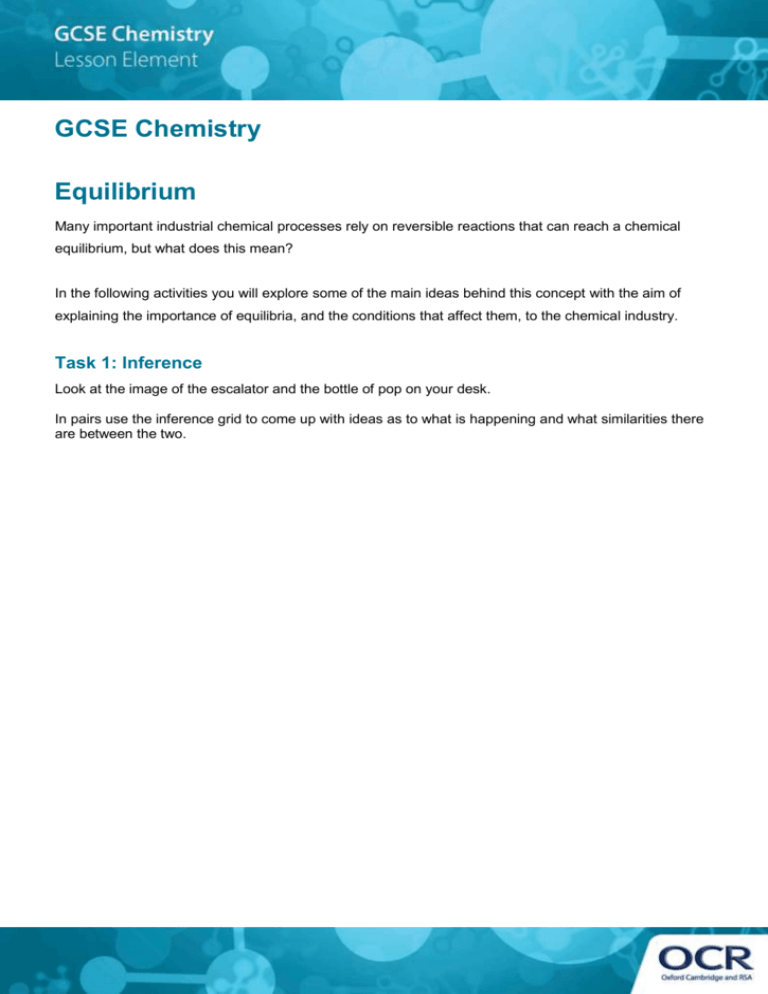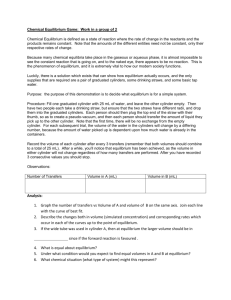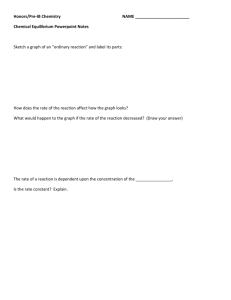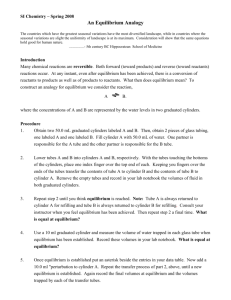Equilibrium activity
advertisement

GCSE Chemistry Equilibrium Many important industrial chemical processes rely on reversible reactions that can reach a chemical equilibrium, but what does this mean? In the following activities you will explore some of the main ideas behind this concept with the aim of explaining the importance of equilibria, and the conditions that affect them, to the chemical industry. Task 1: Inference Look at the image of the escalator and the bottle of pop on your desk. In pairs use the inference grid to come up with ideas as to what is happening and what similarities there are between the two. Task 2: Bail Out Per Group 2 100cm3 measuring cylinders 2 glass tubes, long enough to reach the bottom of the cylinders and of different internal diameters Water Food Dye Part 1 Pour 100 cm3 of water into cylinder A Place glass tubes in cylinders, place a finger over the upper end and transfer liquid collected to other cylinder (no water will be transferred from cylinder B to A the first time) Repeat this operation many times! Note the final levels of water in both cylinders. Questions 1. How does this simulate a reversible reaction? 2. Does this system represent a closed system? 3. How does this simulate equilibrium? Part 2 Repeat the procedure in part 1 except that this time start with 100cm3 of water in cylinder B. Note the final levels of water in both cylinders. Questions 1. How do the final levels of water in the cylinders compare with the final levels in part 1? 2. What does this tell us about reversible reactions and equilibrium? Part 3 Add a few drops of food dye to one of the cylinders from part 2 and mix thoroughly using the glass tube as a stirrer. Continue transferring water between the cylinders in the way described in part 1. Note what happens to the colour in both tubes. Questions 1. How does this help us to understand what is meant by a dynamic equilibrium? Task 3: Equilibrium the Board Game Rules You will need one die and one counter. Mix the Challenge and Equilibrium cards up and place them face down in the centre of the board. Work in pairs (two taking on role of reactants and two taking on role of products). Reactant pair throws the die and moves the counter around the board towards the product. The reactant pair then throws the die a further three times and moves the counter with each throw. Product pair then starts, moving towards the reactant' moving in the opposite direction. Take it in turns to throw the die and move towards your goal. When you reach an ‘Equilibrium’ block on the board select a card from the centre of the board and follow the instructions. If you get a Challenge question you need to make a decision about how the conditions on the board affect the equilibrium position. If you want to, you can pass on a Challenge question. The game should be played for around 15 minutes or until one party reaches the other side. After the game, answer the questions relating to the game. Extension Activities Produce your own cards for the game. Research either the Haber or Contact Process and the requirement for the various conditions of production. Equilibrium Game Follow up questions 1. Why do you think the Reactants players are allowed a ‘Head Start?’ 2. What is meant by exothermic and endothermic? 3. Why is the thermal decomposition of Calcium Carbonate not normally considered as a reversible reaction? 4. Describe the factors that affect the Equilibrium position. 5. Why is it important to understand the impact of these factors on a reaction? 6. Why were both teams allowed to move when a catalyst was added? 7. Explain the link between Equilibrium and Rate of Reaction. Extension Using the Game cards produce a set of rules to show how these factors affect the equilibrium position of a reaction.









